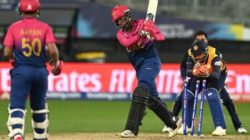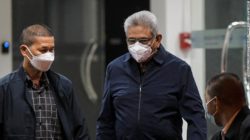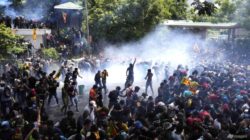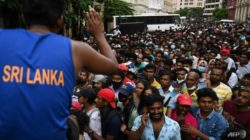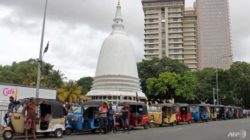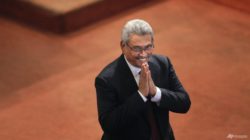Protesters later broke into the home of Wickremesinghe and set it on fire. Video footage on local news channels showed a huge fire and smoke coming from Wickremesinghe’s private home in an affluent Colombo neighbourhood. His office said protesters had started the fire.
There were no immediate reports of injuries in the blaze. Wickremesinghe had moved to a secure location earlier in the day, a government source told the Reuters news agency.
Wickremesinghe has also announced his own impending resignation but said he would not step down until a new government is formed.
“Today in this country we have a fuel crisis, a food shortage, we have the head of the World Food Programme coming here and we have several matters to discuss with the IMF,” Wickremesinghe said. “Therefore, if this government leaves, there should be another government.”
Wickremesinghe said he suggested to the president to have an all-party government, but did not say anything about Rajapaksa’s whereabouts.
Thyagi Ruwanpathirana, a researcher at Amnesty International, told Al Jazeera that Sri Lanka will “not come out of this crisis for some time”.
“There is a lot of wait and watch, and that is affecting the people,” she said.
“We have not had fuel for days … Just imagine running out of fuel. People cant get to work. Kids can’t get to school. The whole economy is at a standstill,” she said from Colombo.
Saturday’s protest began with thousands converging on Colombo’s Galle Face Green square in one of the biggest anti-government protests the crisis-hit island has seen this year. Soldiers and police at the president’s official residence, which is located near the protest site, were unable to hold back the crowd calling for Rajapaksa’s resignation.
In all, at least 39 people, including two police officers were injured and hospitalised amid the protests, hospital sources told Reuters.
Reporting from Colombo, Al Jazeera’s Minelle Fernandez said tens of thousands of protesters had arrived in Colombo for the protests.
“People stormed railway stations and literally forced employees to put them on trains and bring them to Colombo,” she said. “They say they are taking their country back.”
Many in the island nation of 22 million people blame the country’s decline on Rajapaksa.
Largely peaceful protests since March have demanded his resignation.
“I came here to chase away the president. The situation in the country is not good. He has to go for our country to come out of this abyss,” Gihan Roshan, 38, told Al Jazeera earlier in the day.
Complete mayhem
Sri Lanka is struggling under a severe foreign exchange shortage that has limited essential imports of fuel, food and medicine, plunging it into the worst financial turmoil in 70 years.
Months of protests had nearly dismantled the Rajapaksa political dynasty that has ruled Sri Lanka for most of the past two decades. One of Rajapaksa’s brothers resigned as prime minister last month, and two other brothers and a nephew quit their cabinet posts earlier.
Wickremesinghe took over as prime minister in May and protests temporarily waned in the hope that he could find cash for the country’s urgent needs. But people now want him to resign too, saying he has failed to fulfil his promises.
One demonstrator held the Sri Lankan flag in one hand and a placard in the other that read: “Pissu Gota, Pissu Ranil” (Insane Gota, Insane Ranil) in Sinhalese.
When university students and other protesters congregated on a road leading to the president’s house on Saturday afternoon, police responded with tear gas,
“There’s been a heavy security and special task force presence. The comeback was completely over the top with tear gas canisters raining down to disperse the protesters. There was complete mayhem, almost a stampede to get out,” Fernandez reported.
The clashes came after police withdrew a curfew they had imposed in Colombo and several other cities, amid objections by lawyers and opposition politicians who called it illegal. “Such a curfew is blatantly illegal and a violation of the fundamental rights of the people of our country,” the Bar Association of Sri Lanka said.
Discontent in Sri Lanka has worsened in recent weeks as the cash-strapped country stopped receiving fuel shipments, forcing school closures and rationing of petrol and diesel for essential services.
“The economy has collapsed. Most can’t have three meals a day,” Imasha Ranasinghe, a 22-year-old university student told Al Jazeera.
He is among the millions squeezed by chronic fuel shortages and inflation that hit 54.6 percent in June.
Political instability could undermine Sri Lanka’s talks with the International Monetary Fund to obtain a $3bn bailout package, a restructuring of some foreign debt, and fundraising from multilateral and bilateral sources to ease the dollar drought.
Speaking from Colombo, economist Chayu Damsinghe told Al Jazeera he hoped the protests would bring in a change in the country.
“Once that change happens, once the heads at the helm change, there is some sense that policy change can actually be implemented and accepted by the people,” he said earlier on Saturday.
“Last time the people really protested, there was a real change. It is increasingly likely the president will have to take real steps towards change.”



